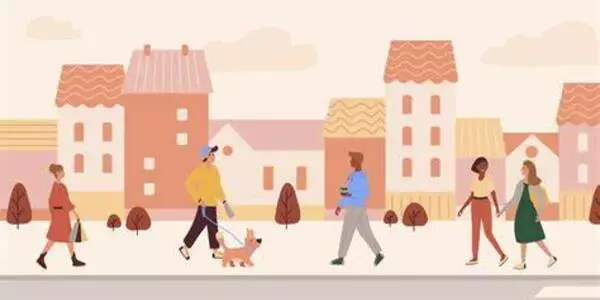Walkable neighborhoods contribute significantly to social interactions and the development of a strong sense of community. It encourages people to leave their homes and walk around, resulting in increased foot traffic in public spaces such as sidewalks, parks, and local businesses. The likelihood of chance encounters and spontaneous interactions among residents increases as more people are out and about.
Adults who live in walkable neighborhoods are more likely to interact with their neighbors and have a stronger sense of community than those who live in car-dependent communities, according to researchers at the University of California San Diego’s Herbert Wertheim School of Public Health and Human Longevity Science.
The study’s findings, which were published online in the journal Health & Place, support one of the six foundational pillars proposed by United States Surgeon General Vivek Murthy as part of a national strategy to address a public health crisis in this country caused by loneliness, isolation, and a lack of connection.
The Surgeon General’s Advisory stated in May 2023 that loneliness and isolation can lead to a 29% increased risk of heart disease, a 32% increased risk of stroke, a 50% increased risk of developing dementia among older adults, and a more than 60% increased risk of premature death.
To address this public health crisis, the Surgeon General recommends strengthening social infrastructure by designing environments that promote connection.
Our built environments either create or deny long-lasting opportunities for socialization, physical activity, contact with nature, and other experiences that affect public health.
James F. Sallis
“Our built environments either create or deny long-lasting opportunities for socialization, physical activity, contact with nature, and other experiences that affect public health,” said James F. Sallis, Ph.D., Distinguished Professor at the Herbert Wertheim School of Public Health and senior author of the UC San Diego study.
“Because transportation and land use policies in the United States have strongly favored car travel and suburban development, millions of Americans live in neighborhoods where they must drive everywhere, usually alone, and have little or no opportunity to interact with their neighbors.”
Walkable neighborhoods encourage active behaviors such as leisure walking or walking to school, work, shopping, or home.

The researchers examined data from the Neighborhood Quality of Life Study, which included 1,745 adults aged 20 to 66 who lived in 32 neighborhoods in and around Seattle, Baltimore, and Washington, D.C.
According to the first author, Jacob R. Carson, M.P.H., a student in the UC San Diego-San Diego State University Joint Doctoral Program in Public Health, neighborhood walkability may promote social interactions with neighbors such as waving hello, asking for help, or socializing in their homes. Carson began his research while studying for a Master of Public Health at the Herbert Wertheim School of Public Health.
Neighborhoods with few gathering places and where people must drive in and out may have the opposite effect, preventing neighbors from socializing.
“Improving social interaction is a critical public health goal.” “Knowing the role of neighborhood design strengthens our ability to advocate for the health of our communities and the people who live in them,” Carson said.
“Fewer traffic incidents, higher levels of physical activity, and improved neighborhood social health outcomes are just a few of the benefits of designing walkable neighborhoods that can enrich our lives.”
















